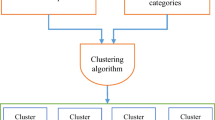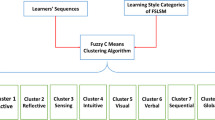Abstract
The e-learners’ excellence can be improved by recommending suitable e-contents available in e-learning servers that are based on investigating their learning styles. The learning styles had to be predicted carefully, because the psychological balance is variable in nature and the e-learners are diversified based on the learning patterns, environment, time and their mood. Moreover, the knowledge about the learners used for learning style prediction is uncertain in nature. This paper identifies Felder–Silverman learning style model as a suitable model for learning style prediction, especially in web environments and proposes to use Fuzzy rules to handle the uncertainty in the learning style predictions. The evaluations have used the Gaussian membership function based fuzzy logic for 120 students and tested for learning of C programming language and it has been observed that the proposed model improved the accuracy in prediction significantly.



Similar content being viewed by others
References
Acampora G, Cadenas J M, Loia V, and Ballester E M 2011 A multi-agent memetic system for human-based knowledge selection. IEEE Trans Syst. Man and Cybernetics, Part A: Systems and Humans, 41(5)
Almohammadi K and Hagras H 2013 An interval Type-2 fuzzy logic based system for customised knowledge delivery within pervasive e-learning platforms. In: Proceedings of IEEE international conference on systems, man, and cybernetics (SMC), 2872–2879
Anozie N and Junker B W 2006 Predicting end-of-year accountability assessment scores from monthly student records in an online tutoring system. In: Proceedings of AAAI workshop on educational data mining, Menlo Park, 1–6
Antunes C 2008 Acquiring background knowledge for intelligent tutoring systems. In: Proceedings of international conference on educational data mining, Montreal, 18–27
Avouris N, Komis V, Fiotakis G, Margaritis M, and Voyiatzaki E 2005 Why logging of fingertip actions is not enough for analysis of learning activities. In: Proceedings of AIED conference on workshop usage analysis learning system, Amsterdam, 1–8
Ayers E, Nugent R, and Dean N 2009 A comparison of student skill knowledge estimates. In: Proceedings of international conference on educational data mining, Cordoba, 1–10
Ba-Omar H, Petrounias I, and Anwar F 2007 A framework for using web usage mining for personalize E-learning. In: Proceedings of international conference on advanced learning technologies, Niigata, 937–938
Baker R, Corbett A, and Koedinger K 2004 Detecting student misuse of intelligent tutoring systems. In: Proceedings of international conference on intelligence tutoring system, Alagoas, 531–540
Barnes T 2005 The q-matrix method: Mining student response data for knowledge. In: Proceedings of AAAI workshop educational data mining, Pittsburgh, 1–8
Beck J E, Baker R, Corbett A T, Kay J, Litman D J, Mitrovic T, and Ritter S 2004 Analyzing student tutor interaction logs improve educational outcomes. Presented at the 7th international conference on workshop, Alagoas
Bergasa-Suso J, Sanders D A, and Tewkesbury G E 2005 Intelligent browser-based systems to assist Internet users. IEEE Trans. Educ., 48(4): 580–585
Butler K 1986 A learning and teaching style in theory and practice. Columbia: Learner’s Dimension
Carver C A, Howard R A, and Lane W D 1999 Enhancing student learning through hypermedia courseware and incorporation of student learning styles. IEEE Trans. Educ., 42(1): 33–38
Cornwell J M and Manfredo P A 1994 Kolb learning style theory revisited. Educ. Psychol. Meas., 54(2): 317–327
Chen Y and Weng C 2009 Mining fuzzy association rules from questionnaire data. Knowl. Based Syst. J., 22(1): 46–56
Chen S -M and Chang Y -C 2011 Weighted fuzzy rule interpolation based on GA-based weight-learning techniques. IEEE Trans. Fuzzy Syst., 19(4): 729–744
Chen C, Duh L, and Liu C 2004 A personalized courseware recommendation system based on fuzzy item response theory. In: Proceedings of IEEE international conference on E-Technology, E-Commerce, E-Service, Washington, 305–308
Chen G, Liu C, Ou K, and Liu B 2000 Discovering decision knowledge from web log portfolio for managing classroom processes by applying decision tree and data cube technology. J. Educ. Comput. Res., 23(3): 305–332
Dekker G W, Pechenizkiy M, and Vleeshouwers J M 2009 Predicting students drop out: A case study. In: Proceedings of international conference on educational data mining, Cordoba, 41–50
Dias S B and Diniz J A 2013 FuzzyQoI Model: A fuzzy logic-based modelling of users’ quality of interaction with a learning management system under blended learning. Elsevier COMPUT EDUC, 69: 38–59
Dunn R 1990 Understanding the Dunn and Dunn learning style model and the need for individual diagnosis and prescription. Read Write Learn Disabil., 6: 223–247
Dunn R and Dunn K 1989 Learning style inventory. Lawrence: Price Systems
Dupre M. J and Tipler F. T 2009 New axioms for bayesian probability. International Society for Bayesian Analysis, 3: 599–606
Elhag M F and Ahmed A H A 2013 Intelligent system for selecting Optimum Instructional style(s) based on fuzzy logic to develop a courseware (ISSIDC). In: Proceedings of international conference on computing, electrical and electronics engineering (ICCEEE), 518–524
Felder R M and Silverman L K 1988 Learning styles and teaching styles in engineering education. Eng. Educ., 78(7): 674–681
Fleming N D 2001 Teaching and learning styles: VARK strategies. N.D. Fleming Christchurch
Garcia-Valverde T, Garcia-Sola A, Gomez-Skarmeta A, and Botia J A 2012 An adaptive learning fuzzy logic system for indoor localisation using Wi-Fi in Ambient Intelligent Environments. In: Proceedings of IEEE international conference on fuzzy systems (FUZZ-IEEE), 1–8
Gardner H 1999 Intelligence reframed: Multiple intelligences for the 21st century. New York: Basic Books
Gilbert J E and Han C Y 1999 Adapting instruction in search of a significant difference. J. Netw. Comput. Appl., 22(3): 149–160
Gregorc A F 1985 Inside styles: Beyond the basics. Maynard: Gabriel sys
Gregorc A F and Ward H 1977 BA new definition for individual: Implications for learning and teaching. NASSP Bull., 401(6): 20–23
Guennoun K and Drira K 2006 Using graph grammars for interaction style description: Applications for service-oriented architectures. IJCSSE, 21(2)
Honey P and Mumford 2000 The learning styles helper’s guide. Maidenhead: Peter Honey Publications Ltd
Jackson C 2002 Manual of the learning styles profiler. Available at http://www.cymeon.com
Jegatha Deborah L, Baskaran R and Kannan A 2014 Learning Styles assessment and theoretical origin in an E-learning scenario: a survey. Artif. Intell. Rev 42(4): 801–819
Jegatha Deborah L, Baskaran R, and Kannan A 2011a Construction of ontology using computational linguistics for E-learning. In: Proceedings of the 2nd international conference on visual informatics, Kualalumpur. Springer—Lecture Notes in Computer Science, pp 50–63
Jegatha Deborah L, Karthika V, Baskaran R, and Kannan A 2011b Deontic based ontology matching for conflict resolution between text documents. In: Proceedings of the international conference on information processing, Bangalore. Springer—Communications in Computer and Information Science, 526–535
Kakoty S, Lal M, and Sarma S K 2012 Fuzzy expert logic to evaluate learner’s expertise level in e-learning environment. In: Proceedings of IEEE international conference on advanced communication control and computing technologies (ICACCCT), 148–152
Kolb A Y and Kolb D A 2005 Learning styles and learning spaces: enhancing Experiential learning in higher education. Acad. Manag. Learn Educ., 4(2): 193–212
Lu F, Li X, Liu Q, Yang Z, Tan G, and He T 2007 Research on personalized E-learning system using fuzzy set based clustering algorithm. In: Proceedings of international conference on computer science, Beijing, 587–590
McCaulley M H 2000 Myers–Briggs type indicator: A bridge between counseling and consulting. Consult. Psychol. J. Practice Res., 52: 117–132
Nebot A, Castro F, Vellido A, and Mugica F 2006 Identification of fuzzy models to predict students performance in an E-learning environment. In: Proceedings of international conference on web-based education, Puerto Vallarta, 74–79
Papanikolaou K A, Grigoriadou M, Magoulas G D, and Kornilakis H 2002 Towards newforms of knowledge communication: The adaptive dimension of a Web-based learning environment. Comput. Educ., 39 (4): 333–360
Paredes P and Rodriguez P 2002 Considering sensing-intuitive dimension to exposition-exemplification in adaptive sequencing. In: Proceedings AH2002 Conf. 556–559
Pittenger D J 2005 Cautionary comments regarding the Myers–Briggs type indicator. Consult. Psychol. J. Practice Res., 57(3): 210–221
Sanders D A 1993 System specification 2. Microprocess. Microprogram., 38(1–5): 833
Sanders D A and Bergasa-Suso J 2010 Inferring learning style from the way students interact with a computer user interface and the WWW. IEEE Trans. Educ., 53(4): 613–620
Swati Chaudhari and Manoj Patil 2014 Study and review of fuzzy inference systems for decision making and control. AIJRSTEM 5(1): 88–92
Tang Z., Er M. J., and Qi F. 2011 Dynamic fuzzy neural network for the intelligent control of a humanoid robot. IJCSSE, 26(3)
Triantafillou E, Pomportsis A, and Georgiadou E 2002 AES-CS: Adaptive educational system base on cognitive styles. In: Proceedings AH2002 Workshop, 10–20
Wilges B, Mateus G P, Nassar S M and Bastos R C 2012 Integration of BDI agent with fuzzy logic in a virtual learning environment. IEEE Trans. Latin Am. (Revista IEEE America Latina), 10(1)
Yang T-C, Hwang G-J and Yang S J-H 2013 Development of an adaptive learning system with multiple perspectives based on students’ learning styles and cognitive styles. Educational Technology & Society 16(4): 185–200
Author information
Authors and Affiliations
Corresponding author
Appendix A
Appendix A
Fuzzy rules
Rights and permissions
About this article
Cite this article
DEBORAH, L.J., SATHIYASEELAN, R., AUDITHAN, S. et al. Fuzzy-logic based learning style prediction in e-learning using web interface information. Sadhana 40, 379–394 (2015). https://doi.org/10.1007/s12046-015-0334-1
Received:
Revised:
Accepted:
Published:
Issue Date:
DOI: https://doi.org/10.1007/s12046-015-0334-1




